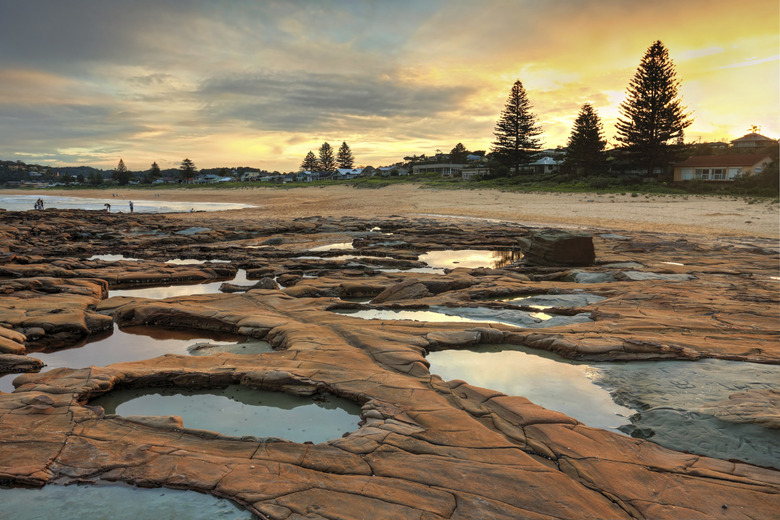Types Of Weathering And Erosion
The forces of weathering and erosion work together like a team — shaping and reshaping the surfaces of the Earth. Weathering is the process of loosening, dissolving and wearing away of the Earth's surface. Mechanical and chemical weathering break down and dissolve solid rocks and minerals thanks to the actions of water, ice, animals, plants, acids, changes in temperature and human activities.
Erosion is the movement of the products of weathering. Erosion takes away the particles of rock and minerals created by weathering, transporting and transforming them into new formations. The agents of erosion are water, wind, ice, people and time.
The Mechanics of Weathering
The Mechanics of Weathering
Both weathering and erosion depend on water and temperature to crack, split and crumble rocks. By alternately freezing and thawing, water acts like a wedge in the crevices and fissures of rocks, breaking them apart and then taking them away in a mechanical process.
In warm regions, another type of mechanical weathering known as "onion skin" erosion takes place as the sun bakes rocks causing them to expand just as bake goods do in an oven. Eventually, pieces flake off like bits of a layered onion. Rain and wind erode the layers. Salt and clay are responsible for another type of mechanical weathering. Rocks break apart when clay swells with absorbed water and other materials. Salt forms crystals that pressurize rocks and break them apart.
Earth’s Laboratory
Earth's Laboratory
Rocks respond to chemical weathering when acids contained in water change their chemical composition. Limestone is easily dissolved by slightly acid rain caused when carbon dioxide from the air combines with water. The process produces limestone formations like Carlsbad Caverns National Park, New Mexico.
Chemical weathering changes the materials that make up rocks and soil. Rocks that contain iron will eventually rust in a process known as oxidation, which causes the rock to expand and break apart. Sometimes, carbon dioxide from the air or soil combines with water. This type of weathering produces carbonic acid that can dissolve rock. Chemical weathering also produces caves, sinkholes and unusual landscapes like the Stone Forest in China.
Earth Sculpting
Earth Sculpting
Weathering and erosion mix rock particles, plant and animal remains to create soil. Living things also cause **biological weathering**. Roots, vines, lichen and moss all loosen rocks and cause weathering to the Earth's surface and human structures such as homes and monuments. Rocks crumble slowly when moles, prairie dogs, livestock and other types of animals tunnel, dig and trample the Earth — another form of weathering.
Rivers and streams pass through the landscape, pick up particles produced by the weathering process and bring this sediment to new locations such as fertile river deltas. Ocean waves constantly erode coastlines and form caves in rocky cliffs — a process that is both erosion and weathering.
Wind and ice also cause both erosion and weathering. Wind turns dust, sand and volcanic ash into dunes and sculpts rocks into works of art like the formations in Arches National Park of Utah. Icy glaciers move on the surface of the Earth, grinding rocks, carving valleys and basins. Mechanical and chemical weathering and erosion carved the Grand Canyon of Arizona.
Humans Join the Action
Humans Join the Action
Weathering and erosion are natural activities, but human activities can contribute to both processes. Burning fossil fuels such as coal and oil and releasing manmade chemicals such as nitrogen oxide and sulfur dioxide will produce acid rain when combined with sunlight and moisture. Many types of stone are worn away by acid rain including historic monuments. Acid rain also affects the forests of the world and causes devastating weathering and erosion that endanger many species of plants and animals. Cutting forests, building dams and agricultural activities contribute to erosion and many environmental problems.
Cite This Article
MLA
Petrona, Amanda. "Types Of Weathering And Erosion" sciencing.com, https://www.sciencing.com/types-weathering-erosion-8473660/. 24 April 2017.
APA
Petrona, Amanda. (2017, April 24). Types Of Weathering And Erosion. sciencing.com. Retrieved from https://www.sciencing.com/types-weathering-erosion-8473660/
Chicago
Petrona, Amanda. Types Of Weathering And Erosion last modified March 24, 2022. https://www.sciencing.com/types-weathering-erosion-8473660/
